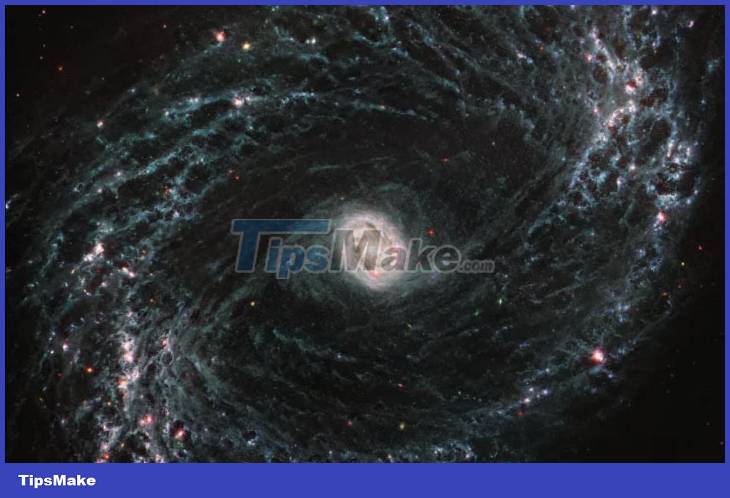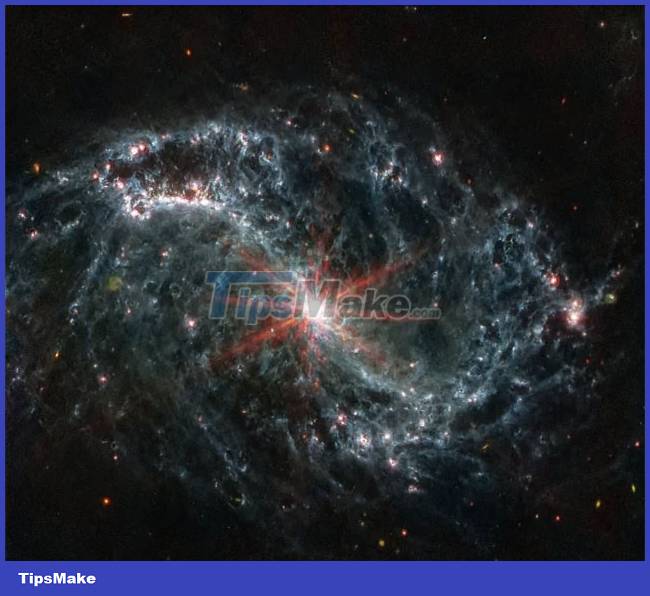Admire the majestic spectacle of swirls of dust and gas in nearby galaxies
In it, the study of the complex structures of dust and gas created and necessary for star formation plays a key role and is of particular importance.
In the past, using telescopes like the Hubble Space Telescope and the Atacama Large Millimeter/submillimeter Array, researchers were able to collect data at a variety of wavelengths, such as visible light. ants and radio wavelengths. Now with the contribution of the world's most modern Space Telescope James Webb, scientists also have the opportunity to have more access to precious data from infrared wavelengths. Infrared observations of the universe allow us to see through clouds of opaque dust at visible light wavelengths, through which structures such as gas and dust surround galaxies.
'James Webb's powerful infrared ability can penetrate dust to connect missing pieces. For example, the specific wavelengths that can be observed by MIRI (7.7 and 11.3 microns) are sensitive to emissions from polycyclic aromatic hydrocarbons, which play an important role in the formation of stars. stars and planets. These molecules were discovered by James Webb in the first observations'.
Example: This picture of galaxy NGC 1433, taken with Webb's MIRI instrument, shows the bright light from the numerous young stars located in the galaxy's spiral arms. These stars emit radiation that blows away dust and gas, 'sculpts' them into various shapes, and then glows in the infrared range in which James Webb operates.

The next image below shows galaxy NGC 7496, also taken with the MIRI instrument of the James Webb Space Telescope. This barred spiral galaxy possesses a busy central region known as the active galactic nucleus that is glowing brightly, and is surrounded by two glowing spiral arms. The shape of the spiral arms originates from the filaments of gas that spread around the giant air bubbles.

So far Webb has collected data from five neighboring galaxies, with more observations of a total of 19 neighboring galaxies expected to be published in the future. This will be a valuable source of research data for astronomers worldwide.
You should read it
- The Most Powerful Space Telescope Ever Built Will Look Back In Time To The Dark Ages Of The Universe
- NASA successfully launched the James Webb space telescope, a 'time machine' that gives us a look into the past of the Universe
- Admire the 'very different' image of Saturn under the eyes of the Hubble telescope
- Admire incredibly detailed images of the Orion Nebula through the eyes of the James Webb telescope
- The majesty of the largest galaxy cluster ever known under the eyes of the $10 billion telescope
- James Webb captured the most difficult to find object in the universe, 2,000 light years away
- James Webb super telescope begins to investigate the mystery of Earth's water source
- The 'white whale' planet was observed for the first time by a $10 billion telescope
- Detecting a mysterious question mark in the universe
- Admire the magical beauty of the Rho Ophiuchi star system through the eyes of the James Webb . telescope
- Astronomers discovered a 'candy cane' in the center of the Milky Way
- The world's most expensive telescope captures stunning views of the famous supernova remnant
May be interested

Ukrainian Space Industry Can Give ESA's Initiatives a Strong Scientific Boost

James Webb captured the most difficult to find object in the universe, 2,000 light years away

Galaxy merger moment gives glimpse into Milky Way's future

The moment two galaxies collide in a super rare image taken by the Gemini North telescope

Cluster of galaxies so large that it can skew space-time and bend light

4 websites to help see where the ISS station is in the sky






 The number of galaxies in the universe is 10 times more than what astronomers thought before
The number of galaxies in the universe is 10 times more than what astronomers thought before 4 common mistakes when using Nearby Sharing and how to fix it
4 common mistakes when using Nearby Sharing and how to fix it What is fine dust? The harmful effects of inhaling ultra-fine dust in the air you need to know
What is fine dust? The harmful effects of inhaling ultra-fine dust in the air you need to know We are inhaling super fine dust PM2.5, the most dangerous dust in the world can penetrate into human body cells
We are inhaling super fine dust PM2.5, the most dangerous dust in the world can penetrate into human body cells The propellers are usually dusty, why?
The propellers are usually dusty, why? Learn immediately the computer dust blower that is loved by professional gaming people
Learn immediately the computer dust blower that is loved by professional gaming people